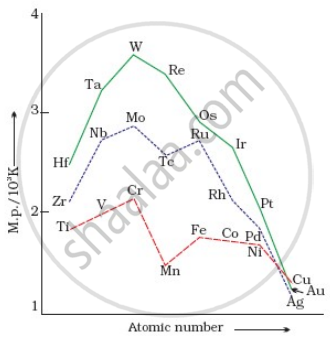Advertisements
Advertisements
प्रश्न
Compare the general characteristics of the first series of the transition metals with those of the second and third series metals in the respective vertical columns. Give special emphasis on the following point:
Ionisation enthalpies
उत्तर
In every series, the first ionization enthalpy generally increases gradually as we move from left to right, although some exceptions are observed in every series. In the same horizontal group, the first ionization enthalpy of some elements of 4d series is higher and that of some elements is lower as compared to the elements of 3d series, although the first ionization enthalpy of 5d series is higher as compared to 3d and 4d series. The reason for this is the weak shielding effect of the nucleus on the 4f electrons in the 5d series.
संबंधित प्रश्न
The elements of 3d transition series are given as: Sc Ti V Cr Mn Fe Co
Answer the following: Write the element which shows maximum number of oxidation states. Give reason.
Explain briefly how +2 state becomes more and more stable in the first half of the first row transition elements with increasing atomic number?
Describe the oxidising action of potassium dichromate and write the ionic equation for its reaction with iodide.
Dissociation of H2S is suppressed in acidic medium.
Why do transition metals exhibit higher enthalpy of atomization?
Metallic radii of some transition elements are given below. Which of these elements will have highest density?
| Element | \[\ce{Fe}\] | \[\ce{Co}\] | \[\ce{Ni}\] | \[\ce{Cu}\] |
| Metallic radii/pm | 126 | 125 | 125 | 128 |
Answer the following question:
Which element of the first transition series has lowest enthalpy of atomisation?
On the basis of the figure given below, answer the following questions:

- Why Manganese has lower melting point than Chromium?
- Why do transition metals of 3d series have lower melting points as compared to 4d series?
- In the third transition series, identify and name the metal with the highest melting point.
The number of terminal oxygen atoms present in the product B obtained from the following reactions is:
\[\ce{FeCr2O4 + Na2CO3 + O2 -> A + Fe2O3 + CO2}\]
\[\ce{A + H^+ -> B + H2O + Na^+}\]
Write the number of unpaired electrons in Cr3+.
(Atomic number of Cr = 24)
